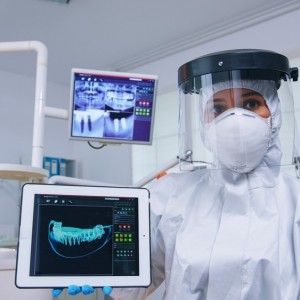
How to remove metal or amalgam gingival tattoos: a new minimally invasive approach
Lara Figini
The blue-gray pigmentation in gingival tissue, called metal or amalgam tattoo, has been found in 3.3% of adults in the United States and is caused by the inadvertent deposition of metal particles, contained in prostheses and dental materials, at the level of the gum adjacent to teeth undergoing dental treatment. The pigmented areas vary from very small spots to large areas that can extend over several teeth and cause serious esthetic problems. Despite awareness about this phenomenon for many years, treatment methods are yet to be established, because of difficulties associated with treatment procedures and the lack of suitable instruments. The traditional treatment is resective plastic surgery of the pigmented gingiva, combined or not with connective tissue grafts and free gingival grafts, however invasive treatments, often complex, not always decisive, as well as being associated with risks or complications, including gingival recessions and defects. post-surgical.
Materials and methods
In a study, published on the Journal of Esthetic and Restorative Dentistry, June 2021, the authors presented a series of cases in which they illustrated a new minimally invasive technique for removing metallic tattoos using laser (Er: YAG). Clinical data were retrospectively collected from 18 patients who had undergone Er: YAG laser treatment to remove metal tattoos. Minimally invasive gingival ablation was performed using an Er: YAG laser directly on the pigmented area, thanks to which the metal debris inside the connective tissue, causing the pigmentation, was exposed and carefully removed. An operating microscope was employed to identify metal debris, and to conduct accurate irradiation minimizing the risk of injury, thus making the treatment minimally invasive. Postoperative gingival color and morphology were then assessed, and patient-reported postoperative pain was analyzed using the visual analog scale.
Results
The metallic tattoos of all patients included in the study were completely and safely removed. Remarkable cosmetic improvements and valid wound healing were achieved with almost no pain or postoperative complications.
Conclusions
From the data of this study, which must be confirmed in other similar studies, it can be concluded that the therapy for the removal of metal or amalgam tattoos that involves the use of the Er: YAG laser is effective and safe, is associated with positive results and has a feedback of aesthetic satisfaction from patients.
Clinical implications
This new technique is much simpler and less invasive than conventional periodontal plastic surgery and may be more reliable with regards to aesthetic gingival improvements as it is associated with favorable wound healing with reduced chair time and postoperative pain.
For additional information: A novel minimally-invasive approach for metal tattoo removal with Er: YAG laser
 Read more
Read more
Digital Dentistry 19 November 2025
Increasing awareness of tooth fracture, both complete and incomplete, as a significant disease entity has led to improved diagnostic techniques.
Editorials 19 November 2025
As Ellen Simmons-Shamrell of the Class of 1977 wrote her annual check for the Michael D. Scotti, DMD Endowed Scholarship—established in memory of her late classmate—she reflected on how different...
Products 19 November 2025
Smartee Denti-Technology has unveiled the Smartee Digital Orthodontic Technology Exhibition Hall, a 1,200-square-meter space dedicated to showcasing the company’s innovations in clear aligner...
News 19 November 2025
Coupa, the global leader in AI-powered spend management, today announced a new collaboration with Specialized Dental Partners, a premier dental support organization (DSO) dedicated to enabling its...
News 19 November 2025
Breakthrough T1D has been selected as a 2025 Health Access Hero Award grant recipient by Sun Life U.S. and DentaQuest.










